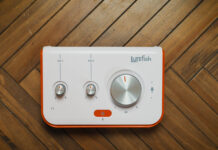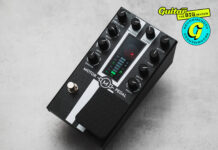
DIY Workshop: Rebuilding Chris Buck’s Eric Clapton Strat
Like all the best Clapton Strats – going back to 1970 – this instrument is a collection of disparate parts. It has been in bits for the last few years, however, and it was pretty wrecked when the owner, Mr Chris Buck, bought it. Chris got a bargain because it came with a non-original body that looked like it had been routed “with a dessert spoon”. Happily, this was recently replaced with a near-mint Pewter-finished genuine Fender body found on Reverb.
READ MORE: Eric Clapton’s 20 greatest guitar moments, ranked
The neck dates to 1993 and has extensive playwear. Unfortunately, the electronics have been playing up but, having found the body, Chris decided it was time to put this guitar back together. Or to be specific, it was time for me to do it. After all, we share some history with derelict Stratocasters.
The potentiometers include a 50k volume control, a dual-gang tone control and a separate volume for the boost circuitSorting the wreckage
Besides the soft V neck profile, Clapton signature Strats are best known for their distinctive electronics. There are two main components to this: Lace Sensor pickups and the onboard preamp/active equalisation.
The volume control operates as usual, but the tone control has a centre indent to mark the null point, and provides treble boost as well as treble cut depending on which way you turn it. This control acts on all three pickups. The second ‘tone’ knob actually controls the preamp and adds up to 25dB of midrange boost.
Clapton Strats feature this preamp circuit board with four transistors. The original Lace Sensors look a little corrodedAll Chris can tell me is that he’s not sure if the electronics are working. Besides a flat battery, I figure it could be either the pickups, the preamp or both. This project begins with a bit of troubleshooting.
Two of the Lace Sensors are broken so this new set will be fittedMeter made
If you plan to do regular work on guitar or amp electronics, a multimeter is essential. Rather than assemble everything straight off and hope for the best, I decide to test the pickups first.
Although they look fancy, Lace Sensors are simply passive pickups with three lead-out wires. Here the orange wires are connected to the five-way selector switch, and the white and green wires are soldered to the volume pot casing – all except the neck pickup, which isn’t connected at all.
The new pickups are mounted, with the orange wires connected to the switch and the green and white ground wires connected to the volume potSetting my multimeter to its 20k resistance range, I get a 5.7k reading from one pickup, but nothing from the other two. As fault-finding goes, it’s an encouraging start, and Chris has provided a set of brand-new Lace Sensors just in case.
You shouldn’t work on projects like this without referring to a circuit diagram and a Google search usually produces the necessary results. Here, Chris is a step ahead of me, and the diagram he provided shows a stereo output socket with three solder tags.
The ground, signal and battery negative wires are temporarily soldered to a new output socket to test the circuitChris’ pile of parts includes an unusual switching socket with four tags, but there’s a new stereo socket attached to the socket cup. I decide to use the new one and temporarily solder the circuit ground, audio output and battery negative wires as shown on the schematic.
With the new Lace Sensors mounted on the pickguard and soldered in, I connect a healthy battery to the battery clip and connect the output to a guitar amp. It’s all quite noisy, but when I tap the pickups I discover they’re working and the controls all appear to be behaving as expected. I attribute the noise to a grounding issue and decide to press ahead with installing the electronics into the new body.
The circuit board is secured with two corner screws and the body ground connection is located just above the coloured wiresMounting up
The preamp circuit board is only attached by the solder joints that link it to the controls, so the whole assembly needs to be handled carefully. Although the board has a screw hole at each corner, Fender only used two, arranged diagonally with plastic spacers placed between the body and the board.
I find a couple of self-tapping screws that seem about the right length and diameter. Although it’s a bit fiddly to keep the spacers in position, I manage to reinstall the board in the hole that’s routed just beneath the pickup cavities.
The board’s lead-out wires pass through a channel into the control cavity, where there’s a hole for the battery clip. The battery is mounted at the rear of the body, in a recess that’s added to the side of the vibrato spring cavity. It wedges in tightly and is held in place by the cover plate.
The battery wedges into this recess adjacent to the vibrato springs and the plastic cover holds it in placeThe ground wires from the spring claw and boost control are routed through to the socket cavity, along with the signal wire and the battery’s negative connection. The signal wire is soldered to the jack socket’s tip tag and the ground wires go to the centre tag, which is permanently grounded. The battery negative connects to the sleeve tag, so when a mono jack plug is inserted, the battery negative connects to ground, which activates the preamp circuit.
Finally, there’s a small indent to the side of the control cavity with a screw used for another ground wire that has a metal connector soldered onto the end. Presumably there’s conductive paint lining the cavities and this adds a further level of noise shielding. It certainly seems to work because when I perform a final check before fixing everything down, the only noise I can hear is coming from the amp. The guitar itself is completely noiseless.
Fret-bevelling tools with diamond files are used to smooth and tidy up the fret endsTo the edge
Inspecting the neck closely, I notice that it has been refretted and the fret ends are protruding from the board, along with several hard Super Glue bumps. After giving the neck a good clean with naphtha, I use my fret-bevelling tools to smooth the fret ends and then tidy up the bevels on both sides.
I round the bevels over with a needle file and polish out any scratches with wet and dry paper followed by 4000-grit Micro-Mesh. The Micro-Mesh also restores the frets to a nice shine. Normally, I would protect the finish with masking tape, but the lacquer Fender was using during the early 1990s can be very brittle and tends to pull away when protective tape is removed.
With the neck looking and feeling a lot better, Chris’ guitar gets a fresh set of stings and a setup. It might benefit from a fret levelling in the future, but for now it’s good to go.
For more about Huw’s work, visit huwpriceguitar.com.
The post DIY Workshop: Rebuilding Chris Buck’s Eric Clapton Strat appeared first on Guitar.com | All Things Guitar.
Source: www.guitar-bass.net












